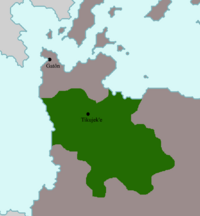Térachu state
Térachu State Itataki P'utusko | |
|---|---|
| 1182–1641 | |
|
Motif reconstruction of the Tsatsa | |
 The Térachu state state in green, with the modern borders of Satucin in dark grey | |
| Capital | Tikujek'e |
| Official languages | Marai |
| Common languages | Gean, Namba |
| Religion | Cutinsuan religion, Solarian Catholicism (after 1551) |
| Government | Monarchy |
| Tsatsa | |
• 1182-1214 | Nindanimbe |
• 1315-1346 | Nitsak'ani |
• 1526-1555 | Francois Tsigalika |
• 1638-1641 | Tsiasa |
| History | |
• Foundation of Tikujek'e | 1182 |
• Gaullican suzerainty established | 1551 |
• Annexation by Gaullica | 1641 |
| Today part of | |
The Térachu State, known internally as Itataki P'utusko (literally meaning Elder Uncle State), and also called Ticujec by early Gaullican settlers, was a polity in pre-Avenard Satucin. It comprised a large part of the modern state of Anniane, and was the second-largest state in pre-Assim Asteria Inferior, after Cutinsua.
It was founded in the late 12th century by the Térachu, a Marai tribe who had migrated into the interior. From the 8th century onwards the area had become largely Marai and urbanised, though not to the extent of the coast. The Térachu founded the city of Tikujek'e, which would later become the capital, and subjugated neighbouring cities. Although it started out as a relatively decentralised tributary system revolving around Tikujek'e, within a century it became highly centralised. While often compared to its contemporaries, Cutinsua, Tzapotlan, Calkhun, Itzel, and !Muisca, it diverged in a key way. Its contemporaries usually defined themselves through a network of urban centres revolving around a metropolis, while the Térachu maintained a marked and fortified border, constituting the first and perhaps only territorial state in the Asterias.
The urban polities of the coastal Marai had largely relied on extensive trade links throughout the Asterias to maintain their urbanisation and wealth, while the Térachu quickly gained access to the mineral wealth of the interior. Gold and salt mines formed the basis of the economy, while an abundance of copper and silver allowed metallurgy to flourish. Items found in both Cutinsua and Térachu indicate a large-scale trade system flourished between the two polities.
The Gaullican arrival in 1537 did not go unnoticed, and in 1545 Rasse Féret and several other explorers were invited to Tikujek'e where they met with the Tsatsa (king) Kunomik'ï.
